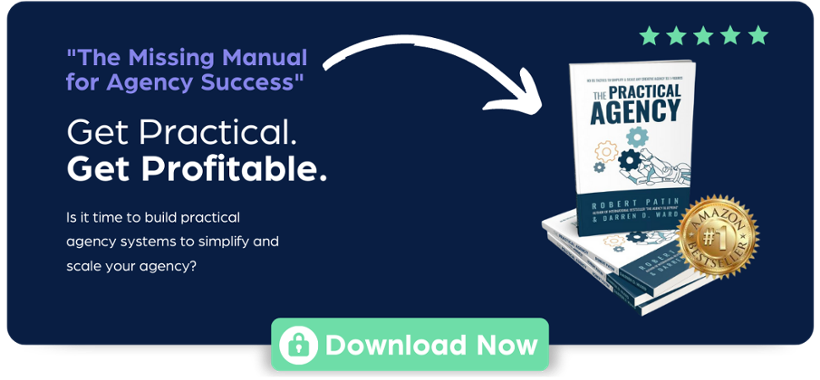Comprehensive Guide: How to Find Your Perfect Digital Marketing Niche

Did you know that the average agency owner undercharges for their services by up to 30%? This surprising statistic isn’t a reflection of lack of experience or technical skills—it’s often due to a single, critical decision that affects every aspect of a creative agency. The choice of your niche not only influences your pricing strategy but also your agency's overall success and growth trajectory.
In the competitive realm of digital marketing, pinpointing the right niche is not just an advantage; it's a necessity. This guide will dive deep into why finding your perfect niche is essential, helping you stand out, attract the right clients, and ultimately, enhance your profitability. We’ll explore strategic ways to discover and capitalize on a niche that aligns with your agency's unique strengths, transforming challenges into opportunities for sustainable growth.
The Power of Focus: Unleashing Profitability Through Strategic Niche Selection
Think about the last time you shopped for a larger purchase, like a smartphone. Chances are - you didn't just walk into the store and buy the first phone you saw. Instead, you chose a model that specifically met your needs—whether it was for better photography, more storage, or simply a brand you trusted.
Similarly, for digital marketing agencies, choosing a profitable niche is no different than selecting the right smartphone. It's about finding that sweet spot where your agency's strengths meet client needs, ensuring each marketing effort is as targeted and effective as your chosen phone's features for your daily tasks.
Specializing allows your agency to develop deep expertise in specific areas, leading to more effective marketing, stronger client relationships, and, ultimately, heightened profitability. By focusing your resources on a well-defined audience, every strategy, campaign, and client interaction is enriched with a level of expertise that broad marketing efforts can't match. Clients in niche markets highly value specialized knowledge and are often willing to pay a premium for expert services that precisely meet their unique needs.
What Makes a Niche Truly Lucrative?
Choosing a niche that's both profitable and sustainable goes beyond personal affinity; it demands thorough research and realistic evaluations. Before you fully commit to a niche, it's vital to ensure that the market can financially support your agency at the rates you need to charge.
To guide you in making an informed decision, here's a checklist that not only considers your emotional connections but also critically assesses the financial viability and growth potential of your niche.
![]() Market Demand: Investigate whether the niche has enduring or growing demand. Tools like Google Trends, industry-specific publications, and keyword research platforms can provide insights into the niche's viability and trends over time.
Market Demand: Investigate whether the niche has enduring or growing demand. Tools like Google Trends, industry-specific publications, and keyword research platforms can provide insights into the niche's viability and trends over time.
![]() Competition Analysis: Is the niche crowded, or is there room for a new player? Utilize SEO tools to assess the number of businesses competing for the same keywords can help gauge market saturation.
Competition Analysis: Is the niche crowded, or is there room for a new player? Utilize SEO tools to assess the number of businesses competing for the same keywords can help gauge market saturation.
![]() Profit Margin Potential: Identify niches where premium services are valued, like niches that require specialized knowledge or certifications. These allow for higher billing rates due to the added value and expertise provided.
Profit Margin Potential: Identify niches where premium services are valued, like niches that require specialized knowledge or certifications. These allow for higher billing rates due to the added value and expertise provided.
![]() Accessibility of Target Clients: How accessible are these prospective clients? Are they active on certain social media platforms, or do they frequent specific online forums or industry events? Understanding where to reach your audience is crucial for effective engagement.
Accessibility of Target Clients: How accessible are these prospective clients? Are they active on certain social media platforms, or do they frequent specific online forums or industry events? Understanding where to reach your audience is crucial for effective engagement.
![]() Alignment with Your Strengths: Choose a niche that plays to your agency’s strengths, such as a sector you have extensive experience in or one where you have unique insights, alignment enhances service delivery and client satisfaction.
Alignment with Your Strengths: Choose a niche that plays to your agency’s strengths, such as a sector you have extensive experience in or one where you have unique insights, alignment enhances service delivery and client satisfaction.
![]() Scalability: Consider the scalability of the services within the niche. Look at whether you can broaden your offerings without a proportional increase in costs or resources as your agency grows.
Scalability: Consider the scalability of the services within the niche. Look at whether you can broaden your offerings without a proportional increase in costs or resources as your agency grows.
![]() Regulatory Considerations: Some niches, especially those involving data security, healthcare, or finance, come with regulatory hurdles. Ensure you understand any regulations and are prepared to meet them, which can also serve as a barrier to entry for competitors.
Regulatory Considerations: Some niches, especially those involving data security, healthcare, or finance, come with regulatory hurdles. Ensure you understand any regulations and are prepared to meet them, which can also serve as a barrier to entry for competitors.
![]() Adaptability: How quickly can you adapt to changes within the niche? Markets evolve, sometimes rapidly, and your ability to pivot can be critical. Evaluate the niche’s historical stability and your agency’s flexibility.
Adaptability: How quickly can you adapt to changes within the niche? Markets evolve, sometimes rapidly, and your ability to pivot can be critical. Evaluate the niche’s historical stability and your agency’s flexibility.
![]() Customer Lifetime Value (CLV): High CLV niches are particularly lucrative. Determine if the niche allows for long-term client relationships and recurring revenue, which are invaluable for sustained growth.
Customer Lifetime Value (CLV): High CLV niches are particularly lucrative. Determine if the niche allows for long-term client relationships and recurring revenue, which are invaluable for sustained growth.
![]() Passion and Interest: Finally, passion counts. Niches where you and your team have genuine interest can lead to more innovative and engaging work, fostering a positive work environment and better creative output.
Passion and Interest: Finally, passion counts. Niches where you and your team have genuine interest can lead to more innovative and engaging work, fostering a positive work environment and better creative output.
5 Key Metrics to Help You Determine the Best Niche For Your Agency
Selecting the right niche is crucial for the growth and longevity of your digital marketing agency. To help you navigate this decision, we've identified five essential metrics that you should consider. These benchmarks will guide you in assessing the viability and potential of a niche before you commit your resources.
- Market Size and Search Volume:
- What to Measure: Use tools like Google Analytics and SEMrush to determine the search volume for keywords related to your potential niche.
- This Matters Because: You need a niche that is large enough to provide a substantial client base but not so competitive that standing out becomes impossible. Ideal niches should show moderate search volume that reflects interest without indicating saturation.
- Average Deal Size and Profit Potential:
- What to Measure: Analyze the average transaction size within the niche and the opportunities for upselling or cross-selling additional services.
- This Matters Because: Higher average deal sizes often indicate a niche's capacity to support premium pricing strategies, essential for enhancing your agency's profitability.
- Growth Trends and Market Development:
- What to Measure: Utilize market research tools like IBISWorld to understand the historical growth rates and future projections within the niche.
- This Matters Because: A niche showing a consistent growth trend of at least 5% annually suggests a developing market with expanding opportunities for your services.
- Competitive Density:
- What to Measure: Assess how saturated the market is by calculating the competitive density using SEO tools like Ahrefs.
- This Matters Because: A competitive density below 0.5 usually means there is enough room for new entrants without intense competition over every prospect.
- Client Retention Potential:
- What to Measure: Look at industries with high client retention rates, typically above 70% after the initial contract period.
- This Matters Because: High retention rates are indicative of ongoing client needs and satisfaction, which can lead to stable recurring revenue and lower customer acquisition costs.
By evaluating these metrics, you can make an informed decision about which niche will not only attract the right clients but also support your agency's growth and profitability in the long term.
Recognizing Red Flags: Identifying Potentially Unprofitable Niches
Before you commit to a niche, it's equally important to recognize the signs that might indicate it's a poor choice. Understanding these warning signs can prevent your agency from venturing into markets that could hinder its growth and sustainability.
Signs You’ve Made A Poor Niche Choice Include:
- Low Search Volume and Engagement: Minimal online search activity and engagement suggest insufficient interest or a too-small audience, making it challenging to generate sustainable business.
- Highly Competitive Markets: A competitive density above 0.75 indicates a saturated market where distinguishing your agency becomes increasingly difficult and less likely to be profitable.
- Low Profit Margins: Niches with inherently low profit margins or those that necessitate high service delivery costs might not align with feasible pricing strategies, impacting overall profitability.
- Poor Growth Projections: Industries showing negative or stagnant growth are unlikely to offer long-term business opportunities, as they might not sustain a growing agency's needs.
- Limited Customer Accessibility: Difficulties in reaching or engaging the target audience due to privacy concerns or niche obscurity can significantly impede effective marketing efforts.
- Short Customer Lifecycle: Niches characterized by short customer lifecycles or predominantly one-off purchase behaviors present limited opportunities for recurring business, which can be detrimental for sustained agency growth.
Evaluating Opportunities: Utilizing Benchmark Metrics for Strategic Niche Selection
As you consider potential niches, it's crucial to align your options with specific benchmark metrics. These benchmarks serve as quantitative standards that can help you objectively assess the viability and potential profitability of a niche.
Use Key Benchmarks to Guide Your Niche Selection:
- Market Growth Rate: Look for niches with a growth rate of at least 5% per year, indicating a healthy and expanding market.
- Competitive Density: Opt for niches with a competitive density below 0.5, suggesting moderate competition and greater chances for your agency to establish a foothold.
- Search Volume: Ensure the niche has a search volume that denotes interest but is not so high as to indicate an oversaturated market.
- Average Deal Size: Choose niches where the average deal size is at least 20-30% above industry norms, which can enhance profitability.
- Client Retention Rate: Prioritize niches with client retention rates above 70% post-initial contract, as high retention rates are indicative of stable, ongoing demand for services.
By methodically assessing these metrics, you can make a more informed decision about which niche will not only resonate with your agency’s capabilities but also offer significant growth and profitability. Selecting the right niche is crucial as it can propel your digital marketing agency toward long-term success, whereas a poor choice might restrict its potential.
Tailoring Your Offer to Market Demands: A Guide to Strategic Market Research
Mastering market research is pivotal for digital marketing agencies. It allows you to not only collect essential data but also to understand the subtle needs and desires of your chosen niche. This detailed insight is crucial for developing marketing strategies and service offerings that resonate deeply with your potential clients, leading to more effective engagements and higher conversion rates.
Essential Market Research Checklist:
![]() Customer Motivations and Pain Points: Delve into the primary drivers of your target audience. Are they looking for ways to enhance efficiency, boost visibility, or surpass their competition? Identifying these key motivations allows you to customize your services to meet these specific needs, making your agency indispensable.
Customer Motivations and Pain Points: Delve into the primary drivers of your target audience. Are they looking for ways to enhance efficiency, boost visibility, or surpass their competition? Identifying these key motivations allows you to customize your services to meet these specific needs, making your agency indispensable.
![]() Decision-Making Factors: Ascertain the factors that influence your niche’s purchasing decisions, such as unique service features, pricing flexibility, or the perceived reliability and reputation of your agency. These insights are vital for shaping your service offerings and crafting compelling marketing messages.
Decision-Making Factors: Ascertain the factors that influence your niche’s purchasing decisions, such as unique service features, pricing flexibility, or the perceived reliability and reputation of your agency. These insights are vital for shaping your service offerings and crafting compelling marketing messages.
![]() Barriers to Purchase: Explore the common obstacles that deter potential clients from engaging with your services. These might include budget constraints, lack of brand awareness, or doubts about the efficacy of digital marketing solutions. Each identified barrier represents a critical opportunity for strategic adjustment and messaging.
Barriers to Purchase: Explore the common obstacles that deter potential clients from engaging with your services. These might include budget constraints, lack of brand awareness, or doubts about the efficacy of digital marketing solutions. Each identified barrier represents a critical opportunity for strategic adjustment and messaging.
![]() Customer Journey Mapping: Chart the typical path your prospective clients traverse from recognizing a need to finalizing a purchase. This mapping helps identify strategic points to introduce persuasive content and supportive interactions that effectively guide potential clients toward choosing your services.
Customer Journey Mapping: Chart the typical path your prospective clients traverse from recognizing a need to finalizing a purchase. This mapping helps identify strategic points to introduce persuasive content and supportive interactions that effectively guide potential clients toward choosing your services.
![]() Market Sentiments and Trends: Utilize tools like social media listening, online forums, and customer reviews to capture the sentiment and ongoing trends within your niche. This real-time feedback is invaluable for fine-tuning your offerings to better align with market expectations and needs.
Market Sentiments and Trends: Utilize tools like social media listening, online forums, and customer reviews to capture the sentiment and ongoing trends within your niche. This real-time feedback is invaluable for fine-tuning your offerings to better align with market expectations and needs.
5 Tips To Converting Research Into Compelling Service Offers:
- Align Services with Client Goals: Tailor your services to directly support the goals of your target market. For example, if increasing visibility is a major driver, emphasize your proven strategies for enhancing online presence.
- Address Specific Challenges: Develop solutions that specifically address the pain points identified in your research. If budget limitations are a common concern, introduce flexible pricing or highlight the long-term ROI of your services.
- Overcome Buying Obstacles: In your marketing materials, directly address the barriers to purchase you've identified. Showing that you understand and can overcome these obstacles can significantly build trust and encourage client engagement.
- Optimize Each Touchpoint: Ensure that your communications are finely tuned to engage effectively at each stage of the customer journey. This targeted communication can decisively influence decision-making and increase conversion rates.
- Iterate Based on Client Feedback: Continuously refine your offerings based on client feedback and market analysis. This adaptability ensures that your services remain relevant and appealing, even as market conditions evolve.
By implementing a comprehensive approach to market research and integrating both qualitative and quantitative insights, you position your agency not just as a service provider but as a strategic partner attuned to the specific needs of your niche.
This alignment is critical for crafting marketing strategies and service offerings that not only attract interest but convert it into engagement and sustained client relationships.
Passion as a Differentiator: Why Authenticity Beats the Competition
In the competitive realm of digital marketing, the difference between blending in and standing out often hinges on the authenticity and passion an agency brings to its niche.
Let’s consider two agencies: Agency A, which has chosen a specific niche within website design and paid ads for eco-friendly products, and Agency B, which offers the same services but without a specific focus, targeting a general market.
Focused Expertise vs. Generalized Approach
- Agency A dives deep into the eco-friendly sector, tailoring their website designs and ad campaigns to resonate with environmentally conscious consumers and businesses. Their team members are genuinely passionate about sustainability, which is evident in their content, from detailed blog posts about eco-friendly marketing trends to case studies showcasing successful green campaigns.
- Agency B, meanwhile, casts a wider net, offering website design and paid ad services to a broad array of clients. While they capture a larger market segment, their messaging and campaigns lack the depth and personalized touch that comes from a specialized focus. Their content tends to be more generic, and while competent, it does not ignite the same level of engagement or enthusiasm among specific audiences.
Authentic Engagement and Market Impact
Clients of Agency A recognize the agency's genuine commitment to sustainability, which aligns with their own values. This authenticity in Agency A’s approach facilitates deeper connections, making their marketing messages more compelling and relatable to their target demographic. The agency's expertise in eco-friendly practices allows them to offer unique insights that generalist agencies simply cannot match.
Conversely, Agency B might struggle to establish a strong identity or memorable brand presence, as their general approach makes it harder to stand out in any specific market. Their broader focus dilutes the impact of their campaigns, making it difficult to resonate deeply with particular audiences, leading to lower engagement and conversion rates.
By choosing a niche and integrating genuine passion into every aspect of their marketing, Agency A demonstrates that a focused and authentic approach not only attracts more engaged and loyal customers but also sets the agency apart from competitors like Agency B, who may see more leads but fewer meaningful engagements and conversions.
Inspiring Niche Ideas for Creative Agencies
In the digital marketing landscape, the right niche can transform a struggling agency into a thriving business. Here’s a list of diverse and profitable niche ideas, each paired with a specific creative problem that agencies can solve, providing a launching pad for those looking to specialize:
- Eco-Friendly Businesses: Focus on companies that sell sustainable and environmentally friendly products. Develop compelling storytelling that highlights sustainability efforts and eco-friendly practices to connect with environmentally conscious consumers.
- Healthcare Professionals: Target private practices, clinics, and wellness coaches. Create HIPAA-compliant marketing strategies that educate and engage patients while maintaining privacy and sensitivity around medical topics.
- Educational Tech Startups: Work with companies creating educational apps and online learning platforms. Design user-friendly interfaces and marketing campaigns that simplify complex educational concepts and engage a diverse student audience.
- Luxury Real Estate: Specialize in high-end real estate markets, catering to luxury property listings. Produce high-quality, immersive virtual tours and sophisticated branding to attract high-net-worth individuals.
- Pet Industry: Focus on pet products, veterinary services, or pet-friendly travel. Develop creative campaigns that capture the emotional bond between pets and their owners, leveraging user-generated content and testimonials.
- Fitness and Wellness: Target gyms, personal trainers, and wellness apps. Create motivational content and personalized marketing strategies that inspire and motivate a fitness-conscious audience.
- Local Artisans and Crafters: Work with local artists, crafters, and makers. Build an online presence that tells the unique story of each artisan, enhancing their visibility and connecting them with enthusiasts and collectors.
- Subscription Box Services: Cater to companies offering monthly subscription boxes in various categories (food, books, grooming products). Design targeted campaigns that drive subscriptions through unboxing experiences and user reviews, highlighting the value and excitement of monthly discoveries.
Each of these niches presents unique challenges and opportunities, allowing creative agencies to deeply engage with specific audiences. By solving these distinct creative problems, an agency can not only establish itself as an expert in the field but also drive meaningful results for its clients.
How To Build Your Newly Targeted Sales Funnel From The Ground Up:
1. Define Your Target Market
Now that we know specializing your niche crystallizes your marketing strategies and ensures your messages hit the mark every time, let’s review how to implement into your own agency:
- Identify Demographics: Start by outlining the age, location, occupation, and income level of your ideal client. For example, if your niche is luxury real estate marketing, your demographic might be affluent professionals aged 35-55.
- Understand Psychographics: Dive into the interests, values, and lifestyle challenges of your target. For instance, if targeting tech startups, focus on values like innovation and scalability.
- Identify Problems You Solve: Clearly articulate the specific challenges your agency addresses. For instance, if you specialize in SEO, how do you improve their search visibility and drive conversions?
- Assess Their Online Behavior: Analyze where your target audience spends their time online—what social platforms they use, the blogs they read, and the content they engage with. This will help tailor your digital presence to intersect with their daily habits.
2. Create and Optimize A Lead Magnet
Now that you know who you want to attract, you’ll need something to offer in exchange for their contact information. Lead magnets are your first exchange of value, making a strong impression while providing tangible benefits to potential clients.
- Offer value by developing lead magnets that address immediate pain points with actionable solutions. For instance, an eBook titled "10 SEO Mistakes That Are Lowering Your Ranking" for a digital marketing agency specializing in SEO.
- Align your services by ensuring your lead magnet introduces potential clients to the type of services you offer, setting the stage for what they can expect from working with you.
- Offer High-quality design by investing in professional design and compelling copy that reflects the high standard of your services, enhancing credibility and appeal.
- Simplify the download or access process. Use tools like landing pages with straightforward forms that request minimal, essential information, ensuring a frictionless experience.
3. Launch an Email Campaign

Effective email campaigns are crucial for nurturing your newly acquired leads, providing them with valuable content that builds trust and positions your agency as the ideal choice.
- Welcome Email: Make a great first impression with a warm, inviting welcome email that thanks new subscribers and gives a brief introduction to your agency.
- Educational Content: Regularly send out well-researched, informative content that addresses common questions or issues related to your niche, helping to establish your authority.
- Engagement Touchpoints: Incorporate interactive elements like quick polls, surveys, or invitations to webinars to foster a two-way conversation.
- Regular Updates: Keep your subscribers informed with updates on new services, case studies, client testimonials, and useful insights into industry trends.
4. Establish a Social Media Presence
Social media isn’t just about being visible—it’s about being actively engaged with your community, listening, and responding to their needs.
- Choose the Right Platforms: Focus on platforms where your target market is most active. For instance, a B2B agency might focus more on LinkedIn, while a consumer-focused agency might invest more heavily in Instagram and Facebook.
- Content Strategy: Develop a content calendar that includes a mix of educational posts, behind-the-scenes looks, client showcases, and interactive content such as polls or live Q&A sessions.
- Engagement Plan: Actively respond to comments and messages, participate in relevant conversations, and use features like stories to keep your audience engaged throughout the day.
- Analytics: Regularly review analytics to understand which types of content perform best and refine your strategy accordingly to maximize engagement and conversion.
5. Establish a Robust Network for Your Agency
A strong network can supercharge your agency's growth. By connecting with the right people, you can open doors to new opportunities, collaborations, and client referrals that might otherwise be out of reach.
- Networking with Service Providers: Identify and connect with other service providers who target your niche but offer non-competing services. For example, if you specialize in digital marketing for healthcare, partner with firms specializing in healthcare IT solutions. Collaborate on webinars, co-authored content, or joint promotions to extend your reach.
- Speaking Engagements: Establish yourself as a thought leader by securing speaking engagements at industry conferences, local business events, or webinars. Tailor your talks to showcase deep insights into your niche, addressing specific pain points and innovative solutions. This not only builds credibility but also puts you in front of a highly targeted audience.
- Leveraging Existing Networks: Tap into the networks of your current clients and business associates. Ask for introductions to other potential clients within their contacts who fit your target market. Offer mutual benefits, such as referral discounts or shared content, to encourage these introductions.
- Social Media Networking: Use social media platforms to join groups and participate in discussions related to your niche. LinkedIn groups, Facebook communities, and even niche-specific online forums can be goldmines for connecting with potential clients and influencers who can amplify your reach.
- Creating Valuable Partnerships: Look for opportunities to create partnerships with companies and individuals that complement your services. For example, if you're a content marketing agency, partnering with a popular SEO tool can provide mutual benefits and increase your visibility among your target audience.
- Utilizing Local and Online Events: Regularly attend both local meetups and online seminars where your target clients might be present. Use these platforms not just for selling but for listening to the needs and trends driving your niche, which can inform your service offerings.
- Offering Workshops or Free Sessions: Host workshops or free consultation sessions that address common issues faced by your target niche. These can be effective lead magnets, giving potential clients a taste of your expertise and how you could help solve their problems.
- Engage with Industry Leaders: Connect with thought leaders and influencers within your niche. This could involve collaborating on content, sharing their insights with your audience, or even interviewing them for your blog or podcast. Their endorsement can significantly boost your credibility.
Ready To Craft a Cohesive Strategy for Sustainable Agency Growth?
Effectively building a targeted sales funnel for your digital marketing agency begins with a deep understanding of your market, enabling you to craft tailored strategies that resonate with your ideal clients. By defining your target demographics and psychographics, creating compelling lead magnets, launching strategic email campaigns, establishing a dynamic social media presence, and cultivating a robust network, you set the foundation for a thriving business. These steps are not just about attracting leads—they're about converting these leads into loyal clients and establishing your agency as a leader in your niche. Each element of your sales funnel should work synergistically to ensure that every interaction adds value, engages your audience, and drives your business towards sustainable growth and success.
Want to learn more? Watch our video below about 5 Steps To Build A Wildly Profitable Agency. Check out our Youtube Channel for more industry insights.









